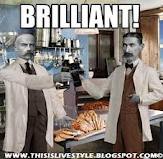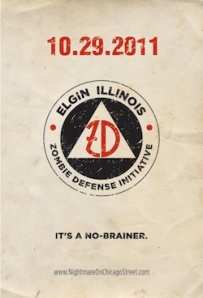 On Monday, I stirred the pot with my post titled “Beware of Fundraising Zombies!” and there has been lots and lots of reaction.
On Monday, I stirred the pot with my post titled “Beware of Fundraising Zombies!” and there has been lots and lots of reaction.
First, let me say thank you to everyone who read that post. Second, let me give an extra special thank you to those of you who forwarded it to others (I always appreciate that). Finally, let me clarify that I am not suggesting donors stop supporting non-profits who are selling tickets to the City of Elgin’s Halloween zombie event. What I advocated for in the post was donors boycotting those agency’s special events, but still sending a check to their charity for the full amount of what they would’ve spent at the event.
I am not suggesting that we put anyone out of business, and perhaps calling for a “boycott” was a bit dramatic . . . but it did get your attention didn’t it? However, I am seriously suggesting that donors can play a huge role in helping non-profits change their behavior when it comes to the art of fundraising.
Perhaps, the most interesting thing to me that came out of Monday’s blog post and subsequent reaction is how many people apparently still grapple with the idea of “return on investment” and what Charity Navigator points out in its study on special event fundraising.
So, I’ve decided to use a purely hypothetical example to clarify this concept. Let’s just say a non-profit organization decided to run a rubber duck race raffle fundraiser. Drilling down into the hypothetical numbers, we might find something like this:
- Gross income = $185,855 (remember that the “in-kind” prizes and media sponsorships are included in this number even though they aren’t cash)
- Gross expense = $128,305 (again, remember that in-kind donations are washed out on both sides of the budget)
- Net income = $57,550 (but this only accounts for “direct costs” and doesn’t take into account hidden indirect costs)
- Let’s hypothetically say the agency’s CEO spends 60% of his/her time over a 12-week period working on this fundraiser. The agency’s Development Director is far more involved and easily sinks 90% of their time into this project during the same time period (this fails to account for the months of planning time incurred throughout the year). Finally, the poor administrative assistant is typing their fingers to the bone entering donations into two separate computer databases. Add up all these salaries and it probably comes to approximately $25,000, which means net income falls from $57,550 to $32,550.
- It should be mentioned that at least 100 volunteers were hypothetically mobilized to make this event happen, and each volunteer probably averaged 10 to 15 hours (which included some combination of staffing two or three duck sales remotes, attending a few meetings/training/kickoff, and the day-of-event operations).
Without allocating other indirect costs (e.g. insurance, utilities, rent, gas for the duck van, payroll taxes, employee benefits, etc), let’s just say this event netted a realistic $32,550. The reality is that most special event fundraisers are not as productive as this hypothetical duck race example and end up closer to ZERO dollars raised or worse yet they end up “in the red” when all of the direct and indirect pennies are counted.
But wait! There is more . . . this duck race analysis wouldn’t be complete without factoring in a small concept like “opportunity cost“.
This same hypothetical non-profit agency ALSO runs an annual campaign (e.g. pledge drive where volunteers ask donors and community supporters to make a direct contribution and forego the fanfare of an event). Drilling down into the numbers, we might find something like this for this hypothetical agency’s annual campaign:
- Gross revenue = $68,322
- Gross expense = $4,174
- Net income = $64,148
- Add indirect costs that come from staff involvement (e.g. CEO, Development Director, Administrative Assistant) and another $7,903 of expense magically appears and the net income drops from 64,148 to $56,244.
Hmmm …. what would happen to this hypothetical agency’s annual campaign if the Duck Race was cancelled and those 100 duck volunteers all agreed to help with the annual campaign?
Let’s say these 100 volunteers all made face-to-face visits with five new donor prospects to the annual campaign. This represents an additional 500 people receiving visits and solicitations. Let’s also pretend that the “average size gift” to the annual campaign is $100 (it is usually much higher in my experience). This would push annual campaign net income up from $56,244 to $106,244.
 Of course, there would be a loss of $32,550 in Duck Race net income in this scenario, but you just picked up $50,000 from shifting volunteer resources to a more productive fundraising activity. In other words, this hypothetical agency just LOST $17,450 by running what looked like (at first blush) to be a highly successful duck race special event. (Some agencies would look at this unrealized $17,450 and think it looks remarkably like a part-time employee position)
Of course, there would be a loss of $32,550 in Duck Race net income in this scenario, but you just picked up $50,000 from shifting volunteer resources to a more productive fundraising activity. In other words, this hypothetical agency just LOST $17,450 by running what looked like (at first blush) to be a highly successful duck race special event. (Some agencies would look at this unrealized $17,450 and think it looks remarkably like a part-time employee position)
Yes … there are holes to be picked in this hypothetical story. For example, there is value in the publicity this non-profit receives from their Duck Race media sponsorships. The 500 new annual campaign asks might not all materialize into pledges. And the picking can go on and on and on. However, please keep in mind that this was a quick, rough and hypothetical example. You can ignore everything I just wrote and it doesn’t get us around the fact that there has been a study by Charity Navigator that empirically proves that special events don’t make money.
To be clear, I am NOT suggesting that non-profit organizations stop doing special events altogether. If they can plan and implement cost-effective events that bring additional intangible benefits, then please add one or two of these events to your annual written resource development plan. If you need help with a Resource Development Audit or writing a Resource Development Plan, I know where you can hire a really talented consultant who is dying to help you. 😉
However, when your local municipality asks that you sell tickets to their special events (with the promise of netting a few hundred dollars) and asks you to recruit your volunteers to help with day-of-event activities, then perhaps you should think twice about committing your agency’s limited resources in such a way.
 Again . . . one final disclaimer. I think the Nightmare on Chicago Street is a great event idea. It is fun and an innovative way for the city to entice residents to rediscover downtown and its merchants. I encourage people to attend, but I encourage them to buy their tickets at the door and not from the non-profits who are selling them. In my experience, non-profits don’t sit-up and pay attention to issues like this one until donors start speaking up. This is a golden opportunity to make a point. Please join me in doing so.
Again . . . one final disclaimer. I think the Nightmare on Chicago Street is a great event idea. It is fun and an innovative way for the city to entice residents to rediscover downtown and its merchants. I encourage people to attend, but I encourage them to buy their tickets at the door and not from the non-profits who are selling them. In my experience, non-profits don’t sit-up and pay attention to issues like this one until donors start speaking up. This is a golden opportunity to make a point. Please join me in doing so.
While I appreciated all of the supportive emails on Monday, I encourage all of you to weigh-in with your thoughts by using the comment box below. Let’s all learn from each other. We can disagree and do so in a respectful manner. After all, this is what America is all about.
Here is to your health! (Sorry for the super long blog post this morning . . . zombies always get me going. LOL)
Erik Anderson
Founder & President, The Healthy Non-Profit LLC
www.thehealthynonprofit.com
erik@thehealthynonprofit.com
http://twitter.com/#!/eanderson847
http://www.facebook.com/eanderson847|
http://www.linkedin.com/in/erikanderson847












